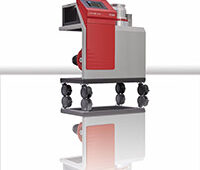Chromatography is a process for separating components of a mixture of chemical substances into its individual components so that they can be thoroughly analyzed. To get the process started, the mixture is dissolved in a substance called the mobile phase, which carries it through a second substance called the stationary phase.
is a process for separating components of a mixture of chemical substances into its individual components so that they can be thoroughly analyzed. To get the process started, the mixture is dissolved in a substance called the mobile phase, which carries it through a second substance called the stationary phase.
The different components of the mixture travel through the stationary phase at different speeds, causing them to separate from one another. The nature of the specific mobile and stationary phases determines which substances travel more quickly or slowly and is how they are separated. These different travel times are termed retention time.
Chromatography was initially used by artists, color theorists and artisans hoping to perfect industrial dyes for textiles. With time, it also spawned a unique branch of chemistry, and with it, the techniques used today to understand and purify mixtures.
By altering the mobile phase, the stationary phase and/or the factor determining speed of travel, a wide variety of chromatographic methods have been created, each serving a different purpose and ideal for different mixtures.
The most common types of chromatography are liquid chromatography, gas chromatography, ion-exchange chromatography, affinity chromatography, but all of these employ the same basic principles.
Chromatography can be used as an analytical tool, feeding its output into a detector that reads the contents of the mixture. It can also be used as a purification tool, separating the components of a mixture for use in other experiments or procedures. Typically, analytical chromatography uses a much smaller quantity of material than chromatography meant to purify a mixture or extract specific components from it.
For example, solid-phase extraction is a kind of liquid chromatography in which different mobile phases are used in sequence to separate out different components of a mixture trapped in a solid phase. Chromatography as a purification technique has major roles in petrochemical and other organic chemistry laboratories, where it can be one of the more cost-effective ways to remove impurities from organic solutions, particularly if the components of the mixture are heat-sensitive.





Tell Us What You Think!